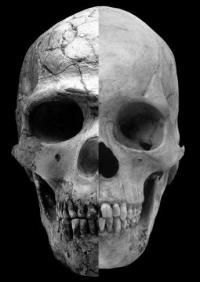Human Advances Came As Testosterone Levels Dropped And People Became Nicer To Each Other

Researchers from Duke University and the universities of Utah and Iowa say a drop in testosterone levels may have been responsible for the development of civilization. Reporting in the journal Current Anthropology, Brian Hare and Jingzhi Tan of Duke, Robert Cieri of Utah and Robert Franciscus of Iowa said as testosterone levels dropped tool-making and art flourished.
The researchers studied more than 1,400 skulls -- some ancient, some modern -- and found as testosterone levels dropped, skulls became rounder and softer, and humans became nicer to each other, allowing them to make technological advances.
Modern humans appeared about 200,000 years ago but tool-making only began about 50,000 years ago, coinciding with the drop in the hormone, the researchers said. The study argues living together and cooperating put a premium on being agreeable and lowered aggression, which in turn led to facial changes, including reduction of the brow ridge.
"The modern human behaviors of technological innovation, making art and rapid cultural exchange probably came at the same time that we developed a more cooperative temperament," lead author Robert Cieri, a biology graduate student at Utah who began this work as a senior at Duke, said in a press release.
"If prehistoric people began living closer together and passing down new technologies, they'd have to be tolerant of each other. The key to our success is the ability to cooperate and get along and learn from one another."
The researchers said, however, it's impossible to tell from the bones whether the amount of testosterone in circulation fell or whether humans lost testosterone receptors.
Hare, who studies differences among apes, said social interactions among chimpanzees and bonobos differ. When chimps are stressed, they produce more testosterone; when bonobos are stressed, by produce more cortisol.
"It's very hard to find a brow-ridge in a bonobo," Hare said.
© Copyright IBTimes 2024. All rights reserved.






















